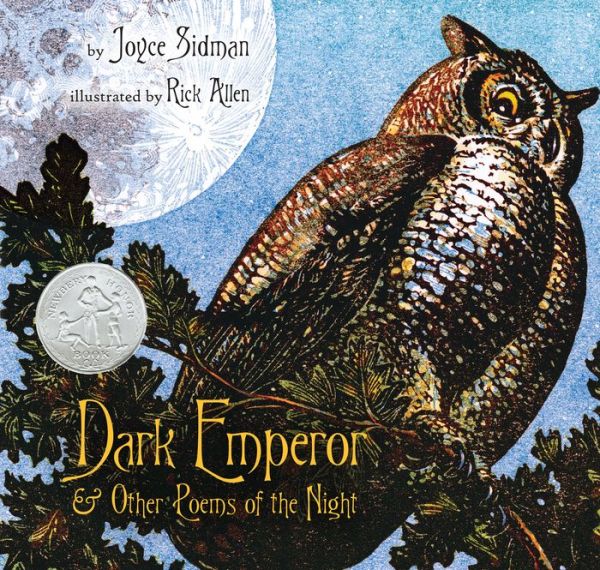
BIBLIOGRAPHY: Sidman, Joyce. 2010. Dark Emperor and Other Poems of
the Night. Ill. by Rick Allen. New York: Houghton Mifflin Books for
Children. ISBN 978-0-547-15228-8
Dark
Emperor and Other Poems of the Night, is a collection of poems by
Joyce Sidman that celebrate the world that comes alive after dark. Sidman has cleverly organized Dark Emperor. The poem collection begins at dusk with “Welcome
to the Night” and ends at dawn when the sun beings to rise with “Moon’s Lament.” In between she features poems about 8 nocturnal
creatures of the night and 2 plants that are found in the woods during the
night.
Included in the margin of each page is a short note on the creature
or object of the night featured in the poem.
These notes give further information about the object’s behaviors and
characteristics. They are also carefully
written and aren’t just full of dry facts.
Instead, Sidman has included factual information that not only adds to
the beautiful poetry and illustrations, but is also interesting and
entertaining for the reader.
There are many poetic forms included in this book such as
verse, lyrical, and concrete. Some poems,
like “Welcome to the Night,” have a clear rhyme pattern while others like “Love
Poem of the Primrose Moth” do not contain any rhyme. Her use of rhythm makes
the poems easy and fun to read and add to the imagery of the poems. Sidman’s use of descriptive language makes
the poems exciting and rich with sensory details. She creates strong mental images with the use
of similes, like “where the moss grows like candy.” In “Oak After Dark” she uses personification “I
stretch my roots into the hill/and slowly, slowly, drink my fill. /A thousand
crickets scream my name, yet I remain the same, the same.” This book of poetry
keeps the reader’s interest by featuring poems that have variations in content
and style.
Rick Allen’s illustrations are gorgeous linoleum cut prints
covered with gouache. Sidman’s poems are
written from the perspective of each creature in the book and Allen’s
illustrations perfectly add to their voice.
The block-prints, combined with dark colors, create a shadowy effect and the
details of the illustrations complement the actions in Sidman’s poems
perfectly. The poetry, illustrations, and informational text in the margins combine to create a rich and informative experience for young and old readers alike.
To all of you who crawl and creep,
who buzz and chirp and hoot and peep,
who wake at dusk and throw off sleep:
Welcome to the night.
To you who make the forest sing,
who dip and dodge on silent wing,
who flutter, hover, clasp, and cling:
Welcome to the night!
Come feel the cool and shadowed breeze,
come smell your way among the trees,
come touch rough bark and leathered leaves:
Welcome to the night.
The night's a sea of dappled dark,
the night's a feast of sound and spark,
the night's a wild, enchanted park.
Welcome to the night!
Welcome to the Night is
the first poem in the book and it welcomes the reader to the nighttime
adventure they are about to embark on. Students could list the different
animals that they see during the daytime and at nighttime. They could
continue to read the rest of the poems into the book and add to the list of
animals that are found during the night. After reading, the children could
choose an animal that isn't mentioned in the book and research its habits and
behaviors. They could write a poem, illustrate it, and write a short
informational paragraph like Sidman has done in her book. The class could
compile all the poems together to create a class book.
Students could also create a movie of the poem they wrote about their animal or about a creature featured in Dark Emperor. They could include pictures of the animal, its habitat, and even include sounds the animal makes.

No comments:
Post a Comment